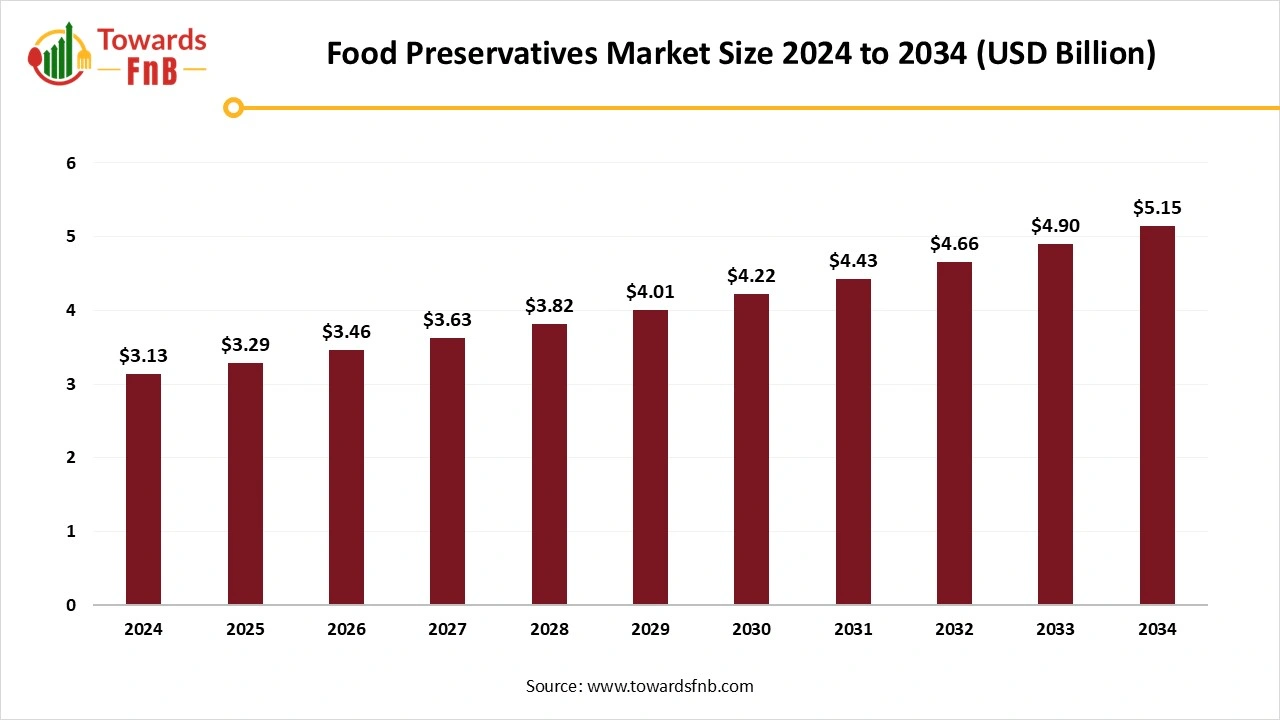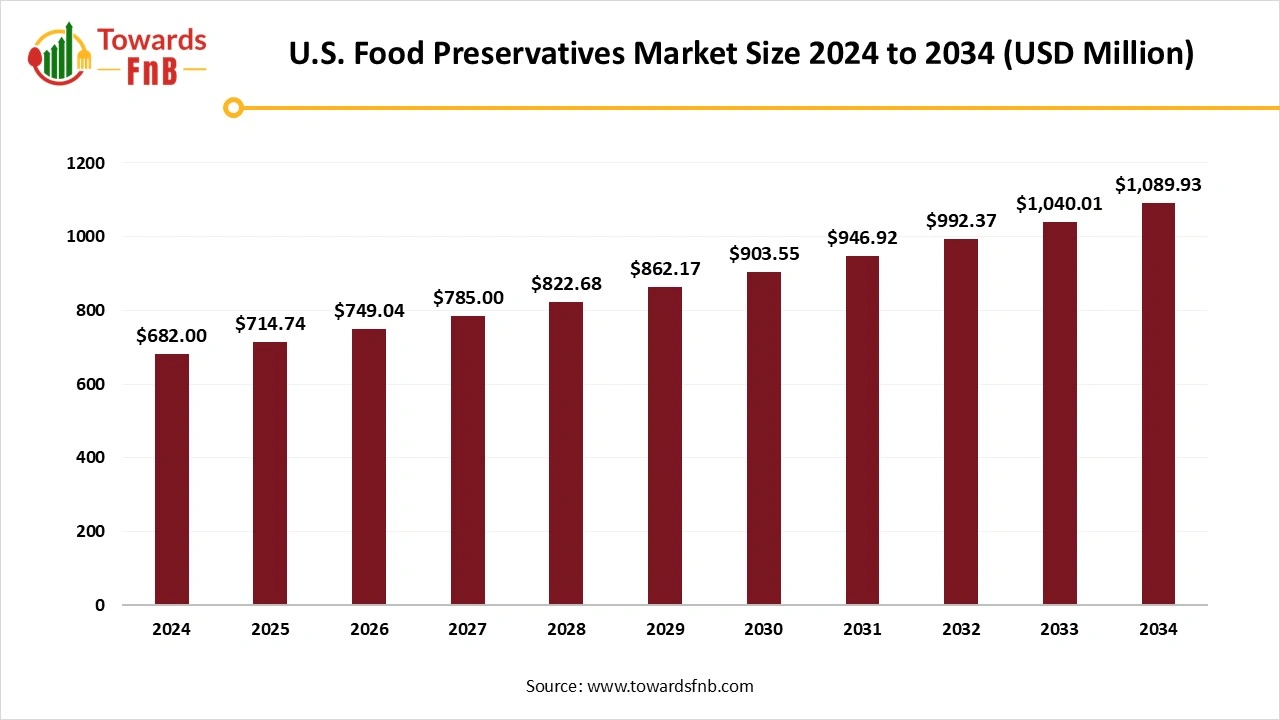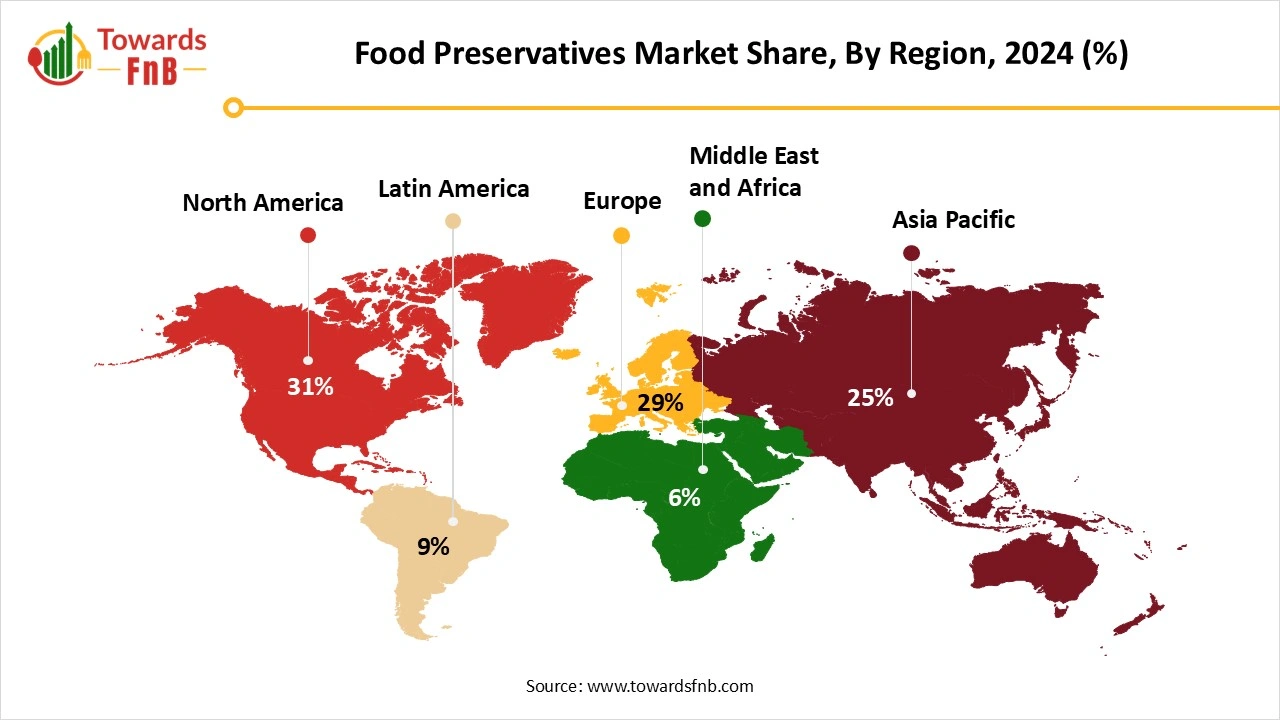November 2025
The global food preservatives market size reached at USD 3.13 billion in 2024 and is anticipated to increase from USD 3.29 billion in 2025 to an estimated USD 5.15 billion by 2034, witnessing a CAGR of 5.1% during the forecast period from 2025 to 2034. The food preservatives market is fostering with increased demand for processed food, the increase in meat and poultry consumption, and increasing demand for products with longer shelf life.

| Study Coverage | Details |
| Growth Rate from 2025 to 2034 | CAGR of 5.1% |
| Market Size in 2025 | USD 3.29 Billion |
| Market Size in 2026 | USD 3.46 Billion |
| Market Size by 2034 | USD 5.15 Billion |
| Largest Market | North America |
| Base Year | 2024 |
| Forecast Period | 2025 to 2034 |
| Regions Covered | North America, Europe, Asia-Pacific, Latin America, and Middle East & Africa |
Food preservatives are substances added to food to prevent the deterioration of food by inhibiting the growth of microorganism and enhance the shelf life of the product. With the swift urbanization and employment worldwide, lifestyle and eating patterns of consumers are shifting tremendously. Consumers are therefore choosing the products that are easy to make and have an extended shelf life. Food preservatives have important role in increasing the shelf-life of food and also keep the food fresh for long period. Hence, with the increase in demand for food with extended shelf-life, the demand for food preservatives increasing and boosting the food preservative market growth.
Consumers are constantly opting packaged, ready-to-consume food that support their hectic lifestyles. Additionally, work routines are becoming more demanding, which is rising the dependence on processed food, including frozen dinners and snack products. such evolving trends are engrossing food manufactures to integrated preservatives to increase the shelf life of the product and preserve flavor, taste, texture, and nutrients.
The demand among consumers for natural or 'clean-label' food ingredients has increased over the last few years and is still expanding. Customers are increasingly conscious of their health and, as a result, demand clarity regarding the ingredient listings. Clean label food preservatives are ingredients that are easily identifiable and trustworthy for consumers. Featuring clear and transparent ingredient lists, these options attract those looking for products that match their values, and they are prepared to spend extra on foods that have natural ingredients like rosemary and green tea on their labels. Such demand for the clen label product creating opportunities to develop natural non-GMO food preservatives to meet demand of consumer.
The preference of consumers for fresh and minimally processed foods presents a challenge for products that include artificial preservatives. Strict regulations concerning the use of specific preservative chemicals also restrict growth potential. Consumers often eat organic food products fresh, reducing the need for long-term storage and, therefore, the use of preservatives. Increasing public awareness of the harmful effects of food preservatives is likely to hinder industry growth.
U.S. Food Preservatives Market Size and Growth 2025 to 2034
The U.S. food preservatives market is valued at approximately USD 682 million in 2024 and is expected to grow from USD 714.74 million in 2025 to nearly USD 1,089.93 million by 2034, reflecting a CAGR of 4.8% from 2025 to 2034. This growth is primarily driven by the rising consumer demand for convenient and processed food products that enhance overall satisfaction and eating experiences.

This market is experiencing steady growth, driven by the rising demand for convenient and processed foods that improve consumer satisfaction and overall eating experiences. The market continues to expand as more consumers seek ready-to-eat and long-lasting food options, encouraging manufacturers to adopt effective preservation solutions.
North America Led the Market in 2024.
Factors such as increasing consumer demand for processed and convenience food, stringent and mandated regulations promoting food safety, and prominent investments in R&D by key market players driving the food preservatives market of North America. Food preservatives in North America are anticipated to change in accordance with increasing customer demand for natural, clean-label, and organic products. Rising health awareness among consumer and demand transparency and traceability in food products, boosting the demand for natural preservatives and expanding the market.

Food Preservatives Market of United States
The increasing consumer desire for convenience and ready-to-eat food products is fueling expansion in the United States food preservatives sector. Consumer demands for convenient foods and organic products with fewer artificial preservatives and enhanced flavor are reshaping the landscape of the American food industry. With an increasing number of individuals getting pets, there is a growing demand for nutritious, high-quality, and shelf-stable pet food. Preservatives play a crucial role in keeping pet food fresh for an extended duration, even in items like dry kibble, canned food, and treats that are frequently held for months before being eaten.
Asia Pacific Expects Significant Growth in the Market During the Forecast Period.
Significant factors contributing for the growth of Asia Pacific food preservatives market are rising urbanization, increasing disposable in income and demand for the processed food including bakery, meat, poultry, frozen dessert etc. demanding the food preservative to extended the shelf life, quality and texture of the products. There is rising affection of Western dietary habits, considering rising indulgence of dairy products such as milk, yogurt, and cheese, increasing the demand for the food preservatives.
The increase of health awareness among consumers in Asia Pacific is also influencing the food additives market, as there is a rising preference for natural and clean label ingredients. Regulatory support and mandated regulations for food safety expanding the market prominently in in China, India and Japan.
Expanding Food Preservatives Market of India
The market for food preservatives in India is witnessing strong expansion, fueled by various crucial elements. To begin with, the growing regional population and evolving dietary choices have driven the need for processed and convenience foods, requiring food preservatives for preservation. Moreover, the growth of organized retail and the e-commerce industry in India has simplified and accelerated consumer access to a broader range of packaged foods. This progress has additionally fueled the need for preservatives.
Aligned with the global food standards established by the Codex Alimentarius Commission and WHO, the Food Safety and Standards Authority of India (FSSAI) has formulated various regulations regarding the use of preservatives. FSSAI, under the Health Ministry, has set the upper limit for additive use in different food categories to guarantee that the acceptable daily intake remains within safe levels. A food business operator must indicate the preservatives present on the label of packaged food products.
Conventional Segment Dominated the Market with the Largest Share in 2024.
Conventional preservatives such as sodium benzoate, sorbic acid, synthetic antioxidants, and chelating agents are favored because they effectively stop microbial growth, prevent oxidation, and prolong shelf life. Moreover, in comparison to natural options, they are often less expensive. The worldwide market supply for conventional preservatives is firmly established. It is crucial to highlight the beneficial qualities of traditional preservatives to comprehend the real difficulties encountered by natural preservative substitutes.
Clean Label segment is Observed to Grow at the Fastest Rate During the Forecast Period.
As buyers grow increasingly aware of their nutrition decisions, the food sector is experiencing change, moving towards clarity in food labeling and non-GMO ingredients. The clean label food trends suggest an increasing desire for foods that are lightly processed and devoid of artificial preservatives. Natural food safeguarding options such as antioxidants and antimicrobials are in harmony with clean label standards and guarantee the safety, quality, and durability of products, catering to consumer tastes. Kalsec study on worldwide consumers reported that, around 70% of consumers indicate they are willing to spend more on food and beverage items that have a clean label.
The Synthetic Food Preservatives Segment Held the Largest Share of the Market in 2024.
Cost effectiveness, efficiency and easy availability of the synthetic food preservatives contributing for its dominance in the market. Synthetic antioxidants such as BHT, BHA and propyl gallate are largely utilized in processed foods, bakery items, and meat and poultry products because of their reduced price than natural antioxidants and their extended shelf life and higher stability, which contribute for their essentiality in the food preservation.
Natural Food Preservatives Segment is Observed to Grow at the Fastest Rate During the Forecast Period.
The negative impact of synthetic preservatives, including allergies and potential long-term health concerns, have contributed for the expansion of natural preservatives. This rising awareness of health impacts is shaping buyers’ preferences also industry trends, with food manufacturers significantly adopting to natural preservatives to complete the rising need for safer and healthier food products. Demand for clean label products is another driving factor changing consumer preference towards natural solutions. Natural preservatives, including vinegar, cayenne pepper, garlic, and oregano, not only extend the shelf life of food items but also offer extra health benefits.
Anti-Microbial Segment Led the Food Preservatives Market in 2024.
Antimicrobial preservatives are compounds utilized in various products to inhibit the proliferation of harmful microbes, thereby prolonging shelf life and securing food safety. These preservatives play a crucial role in preserving product quality by preventing the proliferation of bacteria, fungi, mold, and yeast, rendering them vital in sectors with strict safety and cleanliness standards. Rising worries about food safety and the growing occurrence of foodborne illnesses are leading to a substantial global demand for food preservatives. Natural antimicrobials, such as vinegar, nisin, and natamycin, are increasingly being recognized as viable options to synthetic food preservatives.
Antioxidants Segment is Expected to Grow at the Fastest Rate in the Market During the Forecast Period.
The antioxidant segment is being driven by the increasing demand for convenient foods with extended shelf life. Foods are kept from spoiling and their shelf life is extended with the assistance of antioxidants. Food antioxidants are utilized in various food and drink items such as oils and fats, processed meats, baked goods and sweets, beverages, and snacks. They assist in avoiding rancidity in fats and oils, deterioration of color, loss of flavor, and degradation of nutrients. A broad range of antioxidants, both natural and synthetic, are commonly utilized in food. The primary applications of antioxidants include sweets, oils, baked items, pastries, margarines, cereals, snacks, and sauces. Certain natural antioxidants utilized in the food sector include Ascorbic Acid, Tocopherols, and Rosemary Extract.
Meat and Poultry Segment Held the Dominating Share of the Food Preservatives Market in 2024.
Meat and poultry products are important nutrient option for humans because their prominent protein content, vitamin B groups, essential amino acids, and minerals with high demand among consumers. Along with this, meat and poultry offer proper environment for the food-borne micro-organisms or spoilage microorganisms because their high-water activity and nutrient values. Therefore, there is rising demand of the preservatives for to prevent deterioration of the products.
Dairy Segment is Observed to Grow at the Fastest Rate During the Forecast Period.
The dairy sector has experienced significant expansion, and with rising demand, it is projected to continue growing in the future. Milk serves as a worldwide food resource due to its nutrient density. The primary component for every dairy product is milk. Unprocessed milk has a very limited shelf life. To address this issue, preservatives are incorporated into milk-derived dairy products to extend their shelf life. The preservatives that are most frequently utilized in dairy items like cheese and yogurt include benzoate, sorbate, and natamycin. These substances are typically employed to restrain different kinds of microorganisms. Urbanization is an important trend fostering the dairy sector, with busy consumers seeking for convenient, ready-to-consume, and shelf-stable dairy products like probiotic yoghurt and flavored milk further boosting the demand for preservatives.
Amerex Research and Development
BioVeritas

By Label
By Type
By Function
By Application
By Region
The global high fiber food market size is projected to expand from USD 46.35 billion in 2025 to USD 105.07 billion by 2034, growing at a CAGR of 9.52%...
The U.S. pea protein market size is projected to witness strong growth from USD 748.31 million in 2025 to USD 2,235.45 million by 2034, reflecting a C...
The U.S. food preservatives market size is projected to expand from USD 714.74 million in 2025 to USD 1,089.93 million by 2034, growing at a CAGR of 4...
The global specialty enzymes market size is forecasted to expand from USD 6.73 billion in 2025 to USD 14.08 billion by 2034, growing at a CAGR of 8.55...
November 2025
November 2025
November 2025
November 2025